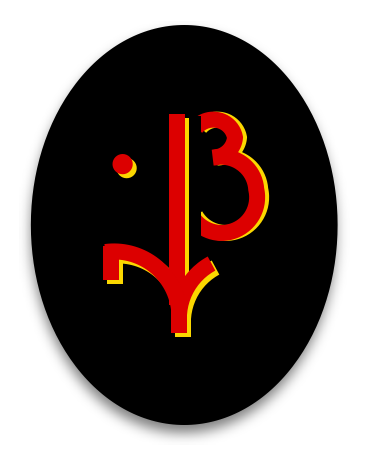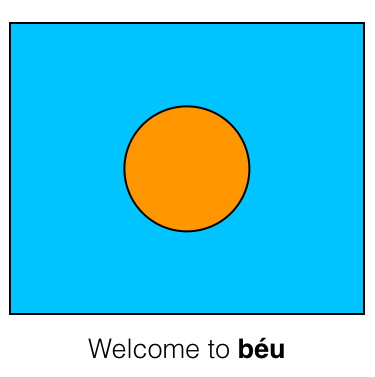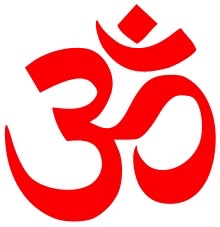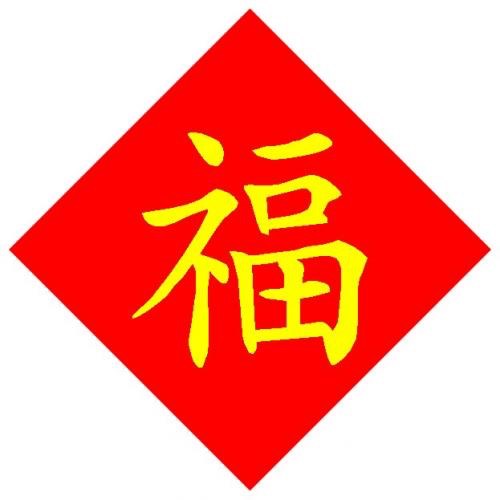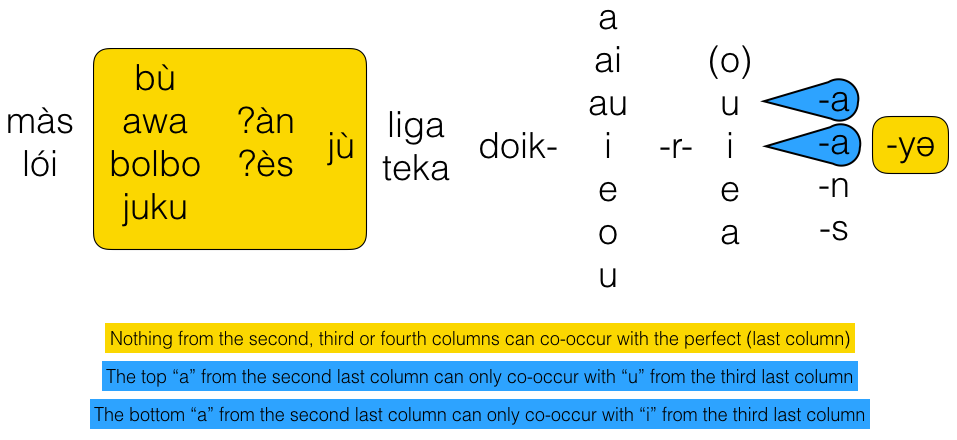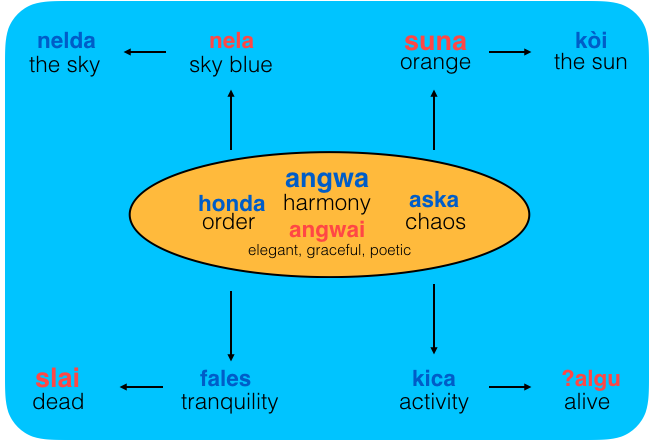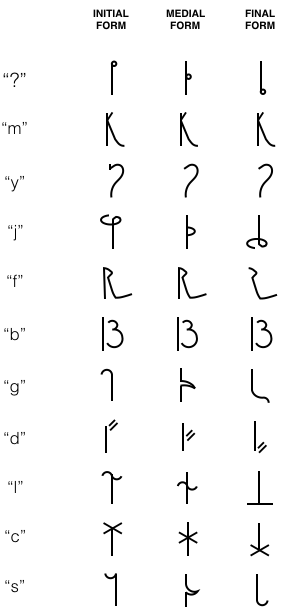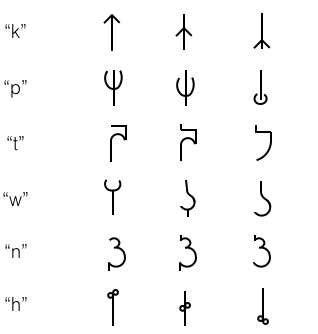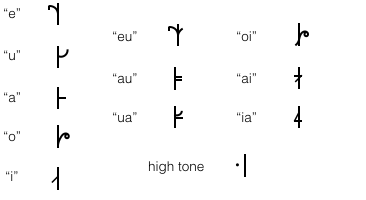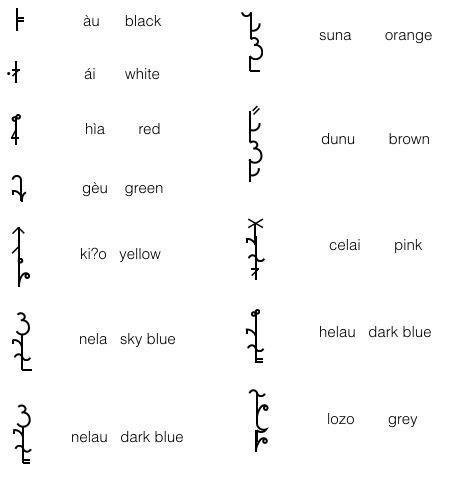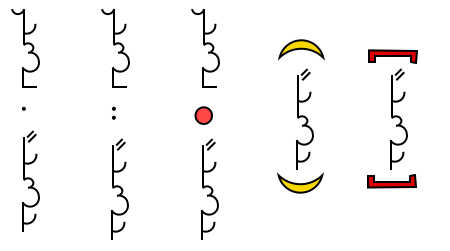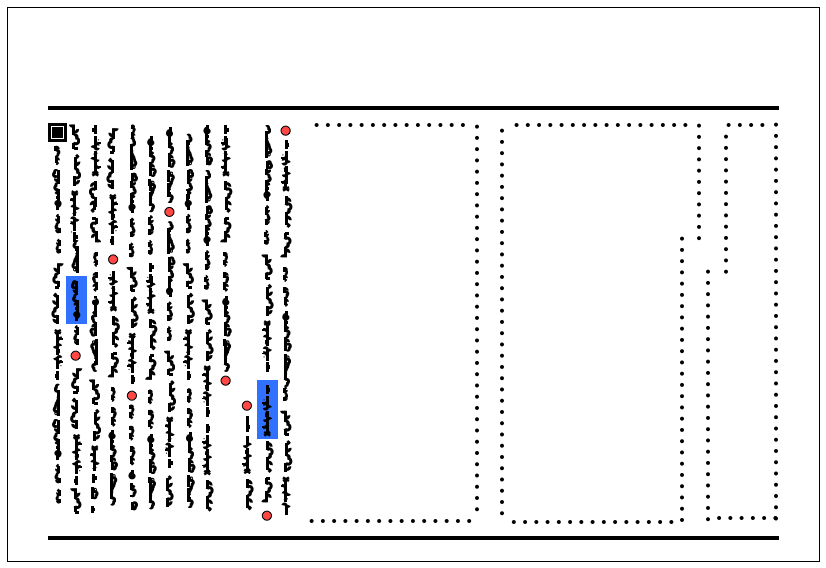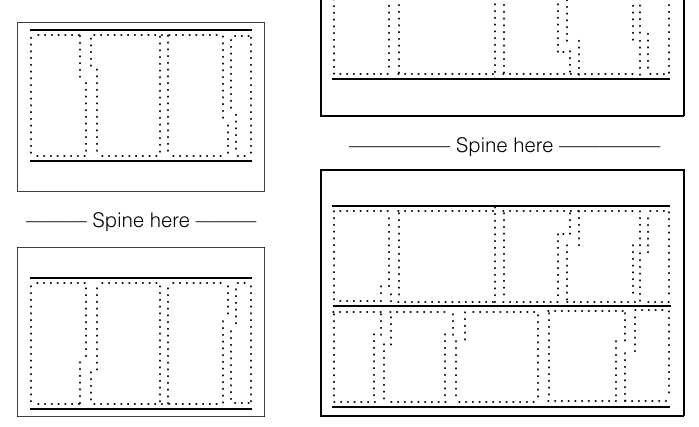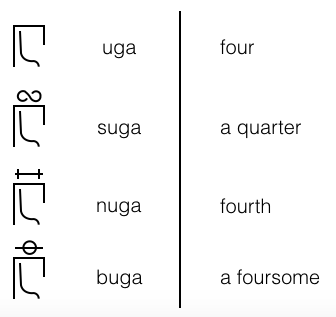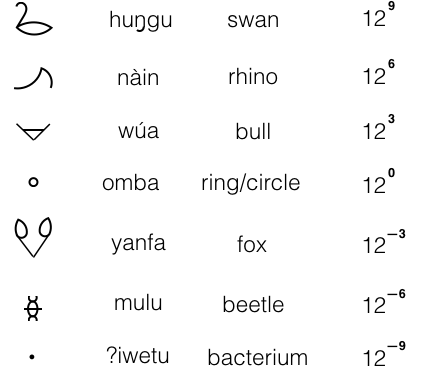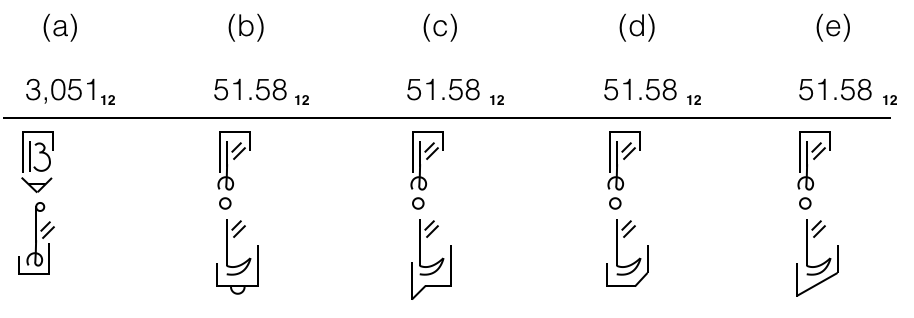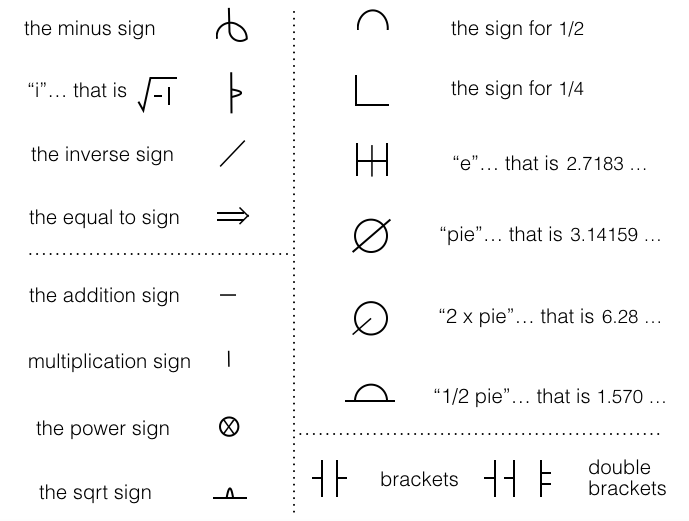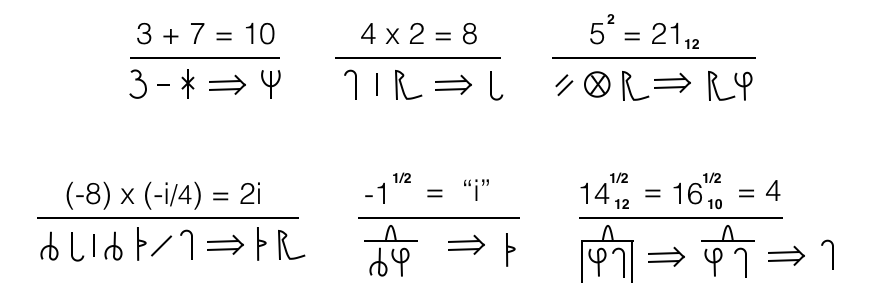Introduction to Béu
..
The development of "Harweng" and "Seuna" ground to a halt because I lacked linguistic knowledge (that is 15 years ago and 7 years ago respectively). béu is the third language that I have started to construct. I intend that it will be a fully formed language and have hopes to finish it in a four or five more years.
What interests me most in linguistics is the area where logic, grammar and semantics intersect.
I admire the languages and conworld created by Tolkien very much. Outside of his work I have not really studied many conlangs. Of the ones that I have come across I like CEQLI ... also the two languages by Dirk Elzinga ... TEPA and SHEMSPREG. I know a little esperanto and think Zamenhof did a great job considerings the resources he had available to him.
The script was devised before the name of the language was decided on. béu was the most visually appealing possible word in the scripts and hence was chosen as the conlang's name (actually I have named the whole constructed culture béu). The red symbol on black background which you can see at the top of this page (on the left and on the right) is the word béu. Pretty cool, eh ? I think it can hold its own when up against "om" or "fú".
..
..
..... The Script
..
Actually the script of béu was inspired by Mongolian https://en.wikipedia.org/wiki/Mongolian_script . I started doodling around trying to get roughly the same affect and quite quickly my script solidified into its present form. I was surprised to learn years later that the Mongolian Script is ultimately derived from the Aramaic Script that was used to run the Persian Empire. A 90 degree shift in writing direction occured under the influence of Chinese.
I am thinking of adopting TAHANO HIKAMU as an alternative script (that is of course, as long as Carsten doesn't mind). The scripts of SEUNA (my conlang attempt prior to béu was inspired by the Tibetan scripts https://en.wikipedia.org/wiki/Tibetan_alphabet : which in my humble opinion is the most delightfully gorgeous scripts ever devised by man. Well that was my opinion before I saw Carsten Becker's opus. Now that appellation must go to TAHANO HIKAMU http://benung.nfshost.com/alphabet .
Some modifications would be needed though. Possibly using the "tupasati" sign to indicate a diphthong as opposed to a long vowel. The one negative is that more trees would be destroyed in a TAHANO HIKAMU world. As its web page says ... "Due to the size of diacritics and the ability to stack them, the line height is usually much larger than in Latin typesetting." But I think the trade-off would be worth it : the loss of a few trees would be outweighed by the gain of having Carsten's script all around.
..
..... The tone system
..
The first noteworthy thing about ‘’’béu’’’ is the 3 tones. All monosyllable words have either a high tone or a low tone. All multi-syllable words have the neutral tone. There were three motivations for this …
..
A) Inevitably multisyllable words are built up from monosyllables. The total number of possible monosyllables allowed by the phonology of ‘’’béu’’’ are nearly all assigned a meaning. I did not want any hint of these meanings surfacing in multisyllable words so it seemed that a good way to distance a word from the monosyllabic words which could comprise it, was to have all multisyllable words in neutral tone and all monosyllabic words in high or low tone.
B) A good percentage of the words languages have tones. I wanted ‘’’béu’’’ to be representative of ALL the world's languages.
C) It doubles the number of possible monosyllabic words.
..
My motivation in construction ‘’’béu’’’ was to make a language that would be aesthetically pleasing to me. Now the natural languages which I like tend to be simple … simple phonology, simple phonotactics and simple grammar. For example Swahili, Thai, Indonesian or Chinese. Now these four languages are not a million miles away from each other in terms of structure. They all have nouns, verbs and adjectives. They all sample reality with the same pixel size (actually I believe all natural languages are similar with respect to this parameter … the only outliers that I know to exist are the conlangs “Ithkuil” and “Toki Pona”, and maybe the natlang “Tok Pisin”). And they are all pretty isolating (the Swahili verb can incorporate a few elements … but there are no irregularities and very few portmanteau forms). It has been suggested that the reason that these languages (at least some of them) are so simple is that they were at one time creoles. Now that which comes before a creole is called a "contact language" … just a list of words taken from two or three languages. However very soon certain words are grammaticized to give some tense aspect information to the verb. Then rules solidify and other common words are grammaticization and become particles/affixes. The result is a creole. All creoles are very simple languages.
I was aiming for the simplicity of a creole ... but with a more “efficient” tense/aspect/evidential system than any creole could possess. Instead of diverse elements incorporated into the verb phrase willy nilly, I … as creator could design a compact, comprehensive paradigm from the get-go.
..
..... My comprehensive paradigm
..
The verb plus related elements is at the very heart of a language so it is worth a brief preview in this introductory section.
Below is the verb meaning "to walk" doika in its presentational? form. This is reduced to doik when in actual use. The seven terms in the next column show who does the action ... for example doika- means "I walk" and doiki means "you walk". The r is used with all active verbs. The five terms in the next column show the time the action ... for example doikeru- means "You lot will walk". The main use of the next column is to show on what evidence the clause is being declared ... for example doikorus- means "They say he/she will walk" ... or doikurun- means "I guess they will walk". They final column has on element. This indicated that the action is done and dusted ... doikurunyə- means "I guess they will have walked".
Below is an example to showcase the complete paradigm ...
lói bù ?àn doikuris = Probably they were no longer walking ... so they say.
This can be analysed as "probably" = lói : "no longer" = bù ?àn : "walking" = doik : "they" = -u : "were" = -i : "so they say" = -s
It can be seem that the system compacts a lot of meaning into a small number of sounds, particularly the elements suffixed to the actual verb ... (for more information on the above go to Ch 1.2)
By the way, a "down stroke" over the first vowel of a word indicates "low tone" and an "up stroke", high tone. All multi-syllable words have a mid tone (usually called neutral tone). Also if you see a "question mark" in a word, it stands for a "glottal stop" sound.
Now I said in the previous section that I wanted ‘’’béu’’’ to be representative of ALL the world's languages. Now it so happens that grammatically the worlds languages can be considered to belong to one of two main camps ... those languages that have the verb before the object and those that have the verb after the object. Whether VO or OV has knock on effects for many other areas for instance VO tends to occur with prepositions and OV with postpositions ... (for more information see The Unfolding of Language by Guy Deutscher).
Now béu sometimes has VO order and sometimes OV order (it depends on the definiteness of the object). Also béu sometimes has prepositions and sometimes it has postpositions (well actually suffixes). This depends on whether it is a single word that is being preposed/postposed or a multi-word phrase.
Only three consonants are allowed word finally n, r and s. I would think this is about the median for the world's languages.
So ... not only with respect to tone, but also with respect to grammar and phonotactics ... béu can be said to represent the whole of humanity.
..
..... Beyond the language
..
Apart from the above-mentioned tones and tense/aspect/evidentials, there is not much worth mentioning about the language of béu … the case system is really not much more than a short-hand convention. It does have the case marker to the left of the NP if the NP is multi-word. And it is suffixed to the word if the NP is not multi-word. I have never heard of any other language doing this but it is not THAT strange.
I think the 7 word classes are pretty neat : but again ... not really worth remarking on.
However it is worth remarking on how béu has expanded from a language to embrace all aspects of life.
I have a feeling that after the language itself is done and dusted, ‘’’béu’’’ will continue to expand in non-linguistic directions.
It is a bit similar to the 613 Mitzvot (laws) of the Torah (except there are many more than 613 ... and non of them are stupid). Actually there are 3 levels for "things you must do" and 2 levels of prohibition.
For example béu specifies "best practices" for many many aspects of life. For example ...
..
* How to greet people when you meet them (and much more about how to talk to other people, about how far you should engage/encroach on them, etc. etc.)
* What an employee can expect from an employer and what an employer can expect from an employee are layed out in quite some detail.
* What help you are expected to give other people. How much time and what resources would be considered reasonable.
* The time of year and the manner of the five big yearly festivals. Also coming of age rites and death rites.
* Technical standards such as screw shapes and sizes, etc. etc are defined in detail.
* The duties of husband to wife and wife to husband are thoroughly defined.
* How to dispose of trash and what is an acceptable level of noise polution.
* The duties of parent to child and child to parent are thoroughly defined.
* What clothes to wear
and much more ...
..
All these rules and habits* which pervade every aspect of life are set up so as to …
..
1) strengthen the things that anchor us to the world and provide meaning
2) to satisfy the yearning for community
3) to give a feeling of “home” in the deepest sense
...
It s necessary to interact with other people … if you do not, you start to loose “feeling of self” … it feels like parts of you are fading away. Other people being aware (caring … hopefully approving … but maybe disapproving) of you and your actions is needed to “reconfirm” that you are a whole person. A bit like if one had to regularly see oneself in a mirror in order not to dissipate into the mist.
As well as this interaction with people, there is a need to be supplied a fixed path through life. You might not be able to keep on this path exactly, but it is important that it should be there. It is “reconfiming” that one can orientate ones journey through life with respect to “the path” It is comforting to have a path to follow … a bit like if you were a child, and nothing bad will happen to you as long as you heed your mother and father.
For the above reason, there are many small rules/recommendations. These are learnt by heart and can be followed automatically ... without too much thought. Many situations that the “béu follower” comes across as they go through life (which otherwise would require thought and could be stressful) are rendered trivial by following the rules/recommendations which are laid down for nearly every contingency.
..
There are current tends to view life as meaningless**. béu rejects this ... béu says that "if the worls is a better place after you have lived your life, then you have had a good life". béu says "there is an optimum way to do everything, and we should try very hard to find this optimum way (probably impossible to get it 100 % right, but you can get pretty close)". béu say do A, do B, do C ... ad infinitum. béu consists of a method where beumi periodocally review A and B and C and adjust as necessary.
There is a possibility of ideas diverging, of people taking two different paths, or even multiple divergent paths. This is acknowledged but not commented on.
In answer to the question "on what authority should all this be done". This question is not acknowledged. Maybe a Zenlike answer can be given.
People like to know exactly what they should do ... they also like to do constructive things. A very obvious thing is to tell them "you must do constuctive things".
It is acknowleged that in the past "the world was a place of limited resourses", that dog eat dog was necessary for survival ... well this is still the case in many places. However in the West nobody really is wanting, nobody goes hungry (the only thing wanting is a direction in life). In a hundred years from now even Africa should be in the position that the West is in now. béu acknowledges that in the past, sometimes destruction was necessary for survival. However the future hold the hope of material comfort for all. béu strives to give that future world spiritual comfort. To give it spiritual comfort with a message that can not be refuted.
..
* Some of these rules and habits are universal. They apply to every beume (follower of béu). Some rules and habits apple to only a single béu community. Some rules and habits apply omly to a single beume (in which case they are more like resolutions than rules). It also should be noted that these rules and habits are not set in stone ... there are mechanisms for reviewing them from time to time.
**After the realization that "there is no God", it was said "you can do what you want". And from that the thought "we are absurd beings loose in a universe empty of meaning".
..
..... The metaphysical world-view
..
..
aŋgwa is the main concept. The closest translation to it is perhaps "harmony".
When used in relation to motion it can be translated as "grace" When used in relation to design it can be translated as "elegance" When used in relation to the written word it can be translated as "poetry"
The adjective corresponding to aŋgwa is aŋgwai
aŋgwa is made up of two sub-concepts ... honda "order" and aska "chaos". aŋgwa is the right balance between honda and aska.
honda and aska are considered two complementary rather than opposing concepts/forces ... a bit like YIN + YANG.
honda and aska are each associated with 4 further concepts. Two of these concepts being nouns (dark blue in the above schematic) and two adjectives (red).
Note ... ONLY these 4 concepts per pole giving 11 concepts in all for the scheme. Unlike YIN and YANG* where for every dichotomy in nature you have YIN claiming one pole and YANG claiming the other.
A euphemism for "to die" is "descend to the blue". Also a poetic way to say "to be born" is "ascend to the sun".
..
The origin of angwa are lost in the mists of time. Probably the ancestral béu community just felt that it fitted. And even in these empirical times, the idea of angwa is still of central importance. For example if somebody shows you around a park, they will probably point out what features are honda and which are aska. Nowadays angwa and related concepts live alongside but separate from modern scientific ideas. By the way the béu flag can be seen at the very top of the page (centre). The flag reflects the aska/honda dualism that permeates the béu way of life.
..
* According to the Taoist tradition ...
Yin is characterized as slow, soft, yielding, diffuse, cold, wet, and passive; and is associated with water, earth, the moon, femininity and nighttime.
Yang, by contrast, is fast, hard, solid, focused, hot, dry, and aggressive; and is associated with fire, sky, the sun, masculinity and daytime.
..
..... Thread writing
..
béu has 17 consonants.
For some of these the form differs slightly, depending upon whether the letter is at word initial, word medial or word final.
The three forms are shown below.
..
béu has 5 vowels and 6 diphthongs.
The form of these doesn't change with their position.
These are shown below.
..
..
To give you better idea of what thread writing looks like, I have listed below the 12 colours of béu.
..
Nice, eh ... sort of organic
..
..... Saying the letters
..
When speaking out the letters, each letter has a word associated with it. This is a bit like when we say "sierra tango echo ..." to spell out a name over the telephone.
| letter | associated name | meaning |
| ʔ | ʔusʔa | a giraffe |
| m | moŋgo | a gibbon |
| y | yeme | a frog/toad |
| j | jamba | a pelican |
| f | fanfa | a horse |
| b | biabia | a butterfly |
| g | gaivai | a flamenco |
| d | duzu | an oryx |
| l | lata | a cow |
| c | compa | a palm tree |
| s | sadu | an elephant |
| k | kiŋki | a fir tree |
| p | pikau | a peacock |
| t | tauta | a hammerhead shark |
| w | wenye | a scorpion |
| n | nùa | a mouse/rat |
| h | habis* | a bee |
We use a different system for the vowels. We add the vowel to san to speak out the vowels. For example ...
To spell naike (sharp) we would say nùa sanai kiŋki sane dù
To spell a vowel that has left.dot (high tone) you substitute dit for san. For example ...
wías (we) would be spelt wenye ditia sadu dù
r is designated by huka (which means hook)
dù is a particle, used with numbers and when spelling, that indicates you have finished a word.
Note ... there is a word dito which means "dot" or "point". Also there is a word santai which means vowel.
táu = letter, character, "symbol used to represent a sound, syllable, word or number"
When a letter is mentioned by itself ( i.e. not as part of a string) it takes the form produced by word building with the above. For example ...
táu gaivai = the symbol given to the sound "g" in béu
táu nùa = the symbol given to the sound "n" in béu
..
* This word has an interesting etymology. alha = flower : alhabis = attracted to flowers
So habis can be seen to be a rubbed down version of alhabis
..
..... Printing
..
Punctuation and Page Layout
..
The letters in a word are always contiguous, that is there is always a line running right through the word. Writing is primarily from top to bottom and secondarily from left to right.
Between words there is a small "break" in the line. The break should be 25% the height of a letter.
Between some words there is a gap. This represents a pause. In béu every place an orator draws breath (or could draw breath) should be reflected in the writing system with a "gap". A gaps hould be 75% the height of a letter.
There are occasions where the grammar of béu demands a gap. I will represent in in my transcription as an underscore.
Side Note ... [ Presumable in English, commas originally were always used for pauses in speech. However nowadays in English many pauses are not represented in any way ... in these places when comma's are not necessary for reading comprehension. Also in English, in a surprising amount of text comma's are found where they shouldn't be. ]
Side Note ... [ When listing items, béu is similar to English ... there is pause between every item except the last two items. Between these items, béu has lé and English has "and" ]
..
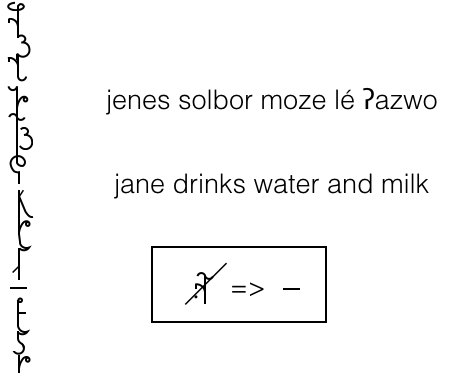 ............................... suna_dunu_celai lé àu = "orange, brown, pink and black" ... [ notice the 2 gaps and the 2 breaks in the béu script ]
............................... suna_dunu_celai lé àu = "orange, brown, pink and black" ... [ notice the 2 gaps and the 2 breaks in the béu script ]
..
By the way, this would be spelled out as ... sadu sanu nùa sana jù_duzu sanu nùa sanu jù_compa sane lata sanai dù_táu lé_sanau dù dù ... [ dù for a break and jù for a gap ]
Note that the word lé has a special symbol ... táu lé. There are about 30 common words that have short-hard symbols. They are never written out in full.
..
Single gaps are very common. Occasionally you can have "double gaps" and even "treble gaps". These rare creatures represent "pregnant pauses" which are sometimes used for comic effect.
Note the single point used in the "double gap" and the pair of points used in the "treble gap".
For a "double gap" there should be 75% letter height space above and below the dot. For a "treble gap" it is the same 75% letter height above and below the dots plus a 25% letter height between the dots.
There is also a punctuation mark called the koipa "sunmark" ( kòi = sun faspa = mark koipa = "sunmark" ) ... always red infill. This is basically a full-stop. The koipa has double the diameter of omba (omba means "circle" and is used as a decimal point).
There are also punctuation marks called deupa "moonmark" ( dèu = moon faspa = mark deupa = "moonmark" ) ... always gold infill. These are basically brackets. The opening one is called deupa damau and the closing one is called deupa dagoi.
..
..
The deupa are solely used as quotation marks. For other sorts of bracketing the form shown above on the RHS should be used. .......... to be named ... "above shelf" / "below shelf" ???
Usually everything is written in "textblocks". Three and a bit "textblocks" are shown on the demonstration page below ... [ I could note be arsed wording all the textblocks, so reverted to dotted lines towards the RHS ]
..
This is the first page in a "chapter" in a paperback book. Notice the symbol at the top left hand side of the first "textblock". This is called a "tile" and is always the first thing in a chapter.
Textblocks fit in between "rails" (the dark horizontal lines) about 4 inches apart. The width of a block should be between 60% and 90% * of the block height. Of course it is best to start a new block when the scene of the narrative changes or there is some other discontinuity of the action, but this is not always possible. One then just must arbitrarily split the text into two blocks. The standard practice is to stretch the text a bit so that the tops and bottoms of every column line up.
There is no way to split a word between two lines as we can do in the West by using two hyphens. A koipa starts of every textblock.
The first text block starts at the top left (as you would expect). The second textblock starts below where the first text block stops. In fact the vertical space between the stop and the start of the two textblocks is equal to the horizontal "interblockspace"). Between textblocks there is a one culumn gap.
In every textblock, one word or short noun phrase is highlighted in blue. The shape of the highlighted area is rectangular with rounded edges. Usually a noun is chosen and the more iconic the better. Statistically these highlighted words tend to come towards the beginning of the "textblock".
There are two sizes for books. For all hardback books the size is about 8 inches by about 11 inches. For all paperback books the size is about 5 inches by about 8 inches. They are stored as shown in the figure below.
..
..
Unlike books produced in the West, these books are held with the spine horizontal when being read. The hardback page has two "rails" per page (i.e. three dark horizontal lines instead of two).
..
..
On the paperback book, the title is written on the spine and on the front of the book. On the hardback book the title is written on the front, also there is a flap that slides into the spine. However when the book is stored on a shelf, it is pulled out and hangs down. Hence the hardback books can be easily located, even when they are in the bookshelf.
A book will be divided into chapters. A chapter will have a number and usually a title as well. Either at the end of the book or just after the chapter, there will be a page, in which all the highlighted words for a chapter are listed in order. Instead of referencing things by page number, things are reference by chapter and textblock (indictated by the highlighted word(s) ).
Any particular word in a book can be reference by 5 parameters ...
1) "title of book"
2) number of the chapter .... will perhaps have a title as well
3) the highlighted word(s) ... these will be numbered ... [ number corresponds to textblock ]
4) the number of koipai passed.
5) the number of the word in the sentence
..
..... Numbers
..
The standard set comprises of the numbers from 1 to 172710 (which is 1 to 100012 in base twelve). Every number in the standard set has a unique form.
Five random numbers are given below to demonstrate ...
| oila | = 6 |
| eucaifa | = 7212 |
| odauba | = 50312 |
| odaugaiba | = 54312 |
| oilaugai | = 64012 |
..
And below is how these numbers are written within a body of text.
..
Within a body of text ("textblock" from now on) a number written vertically and is headed up by a special three sided bracket. The only use of this bracket is to indicate a number within a textblock.
Below this bracket, the number is written with a letter representing each digit of the number
Under the bracket the number is written using a letter symbol.
| letter | digit | ..... | letter | digit | ..... | letter | digit | |||
| J | => | 1 | D | => | 5 | K | => | 9 | ||
| F | => | 2 | L | => | 6 | P | => | 10 | ||
| B | => | 3 | C | => | 7 | T | => | 11 | ||
| G | => | 4 | S | => | 8 |
You can see that base 12 is being used. (just for explanatory purposes I will use "T" for 10 and "E" for 11)
More or less the same symbols is used for the number digit as for the letter. They take their initial, medial or final form, depending on whether the are the first, second or third number of the three digit group. táu ʔusʔa is used for inserting zeroes. táu ʔusʔa is never pronounced, it is only a place holder as number magnitude depends on position.
Although there is a unique word for 1727 numbers, it is not necessary to memorize 1727 unique forms. The 1727 numbers are built up from smaller elements. These elements are shown below ...
..
| 10012 = | ajau | 1012 = | ajai | one = | aja |
| 20012 = | ifau | 2012 = | aifai | two = | ifa |
| 30012 = | ubau | 3012 = | ubai | three = | uba |
| 40012 = | egau | 4012 = | egai | four = | ega |
| 50012 = | odau | 5012 = | odai | five = | oda |
| 60012 = | oilau | 6012 = | oilai | six = | oila |
| 70012 = | eucau | 7012 = | eucai | seven = | euca |
| 80012 = | aizau | 8012 = | aizai | eight = | aiza |
| 90012 = | aukau | 9012 = | aukai | nine = | auka |
| T0012 = | yapau | T012 = | yapai | T = | yapa |
| E0012 = | watau | E012 = | watai | E = | wata |
..
To construct a number from the above ...
1) Select which elements you need. For example, for 54312, you will need the elements odau + egai + uba
2) If the element is non-initial, delete the initial vowel of the element => odau + gai + ba ... (note that ya and wa were originally ia and ua ... they should be deleted)
3) Join the elements up => odaugaiba
..
There is a soecial form for 1, 2 and 3 ... aja, ifa and uba, while used for building up larger numbers, are never used by themselves when qualifying animate things. Instead we use ...
..
| ʔà | one |
| hói | two |
| léu | three |
..
ʔà along with its plural form ʔài are also used to code indefiniteness.
..
Numbers are never written out in full. Always the method given above is used. It is as if in a body of English text you never came across the "seven" but only "7".
With fractions, cardinal numbers and numbers denoting group size, there is the choice of writing 7th or seventh. That is you can either use the symbols given below or you can write out in full ... in this example sega, nega and bega.
..
..
Note ... If you had a leading zero you would use the word jù. 007 would be jù jù euca (three words). To deal with a telephone number, you would lump the numbers in threes (any leading zero or zeroes by themselves though) and outspeak the numbers. If you were left with a single digit (say 4) it would be pronounced egau. If you were to pronounce it ega, it would of course mean 004. Also you would probably add the particle dù at the end.
..
... Numbers ... (the extended set)
..
So far we have covered the standard set (1 -> 1727). To expand this into "the extended set" we use "magnitude" words. There are seven of these.
..
..
The first column gives the magnitude symbol, the second ... how the symbol is pronounced, the third ... the meaning*, and the last ... the magnifier that the symbol represents.
.* Yes all the magnitude words double up as animal names. But actually this never causes any problem. If you hear huŋgu huŋgu you know it means "5,159,780,352 Swans" ... there is no ambiguity.
To demonstrate the use of the magnitude words, let's take a long number ... 1,206,8E3,051.58T,630,559
Which is written as ...
and pronounced as ... aja huŋgu ifaula nàin aizautaiba wúa odaija ʔomba odauzaipa yanfa oilaubai mulu odaudaika ʔiwetu dù
You can see that the digits are still grouped into bunches of three. Within the triplets, leading zeros can be dropped ... giving doublets or even singletons.
All the magnitude words are spoken out. Notice the final dù. This means "exactly". You usually add this when pronouncing numbers from the extended set.
When you write an extended set number, you must finish the number off with a bracket. (in contrast the final bracket is never used if the number is from the standard set)
Anyway ... the above is only an example. You are unlikely to find something with so big a dynamic range within a textblock.
Below are examples of numbers which you would more typically find in a text block ...
Pronounced uba wúa odaija dù and odaija ʔomba odauzai respectively.
(a) uba wúa odaija dù is an whole number.
odaija ʔomba odauzai is not a whole number. Notice that the 4 versions of odaija ʔomba odauzai have been given different kinds of final brackets.
(b) This one shows that 51.5812 is an approximation to the actual value. (pronounced daula)
(c) This one shows that 51.5812 has been rounded down. That is .. if A = "actual value", then 51.59 =< A =< 51.58
(d) This one shows that 51.5812 has been rounded up. That is .... if A = "actual value", then 51.58 =< A =< 51.57
(e) This one shows that 51.5812 has been rounded up or down to the nearest digit. That is .... if A = "actual value", then 51.585 =< A =< 51.575
..
dù and daula ( plus ? plus ? plus ?) as well as giving information about the accuracy of the number, also lets the listener know that the speaker has finished.
..
... Numbers ... (mathematical notation)
..
The numbers considered above were all in what is called "block form". That is ... the form they appear as within a body of text. There is also a way to write numbers when they are not inside a text block. That would happen on a page given over to mathematical formula. In this environment the numbers are written horizontally ... from left to right. There are some slight differences between the free form version of the numbers and the block form versions. The free form version of the numbers are ...
As with the block form, they always occur in triplets. However their form doesn't vary depending on which one of the triplets the character is ... the digits are always exactly the same. There is a special egg-shape symbol for zero (actually called táu kyái, where kyái means "egg"). In free form it is not permitted to drop leading zero's ... well not triplet leading zero's, word leading zero's can of course be dropped.
Below is how the five numbers given previously appear in free form ...
And that long number mentioned in the previous section (a number from the extended set) ...
It is, of course, pronounced exactly as the block form number. That is ... aja huŋgu ifaula nàin aizautaiba wúa odaija ʔomba odauzaipa yanfa oilaubai mulu odaudaika ʔiwetu dù
..
Below are some more symbols used in mathematics. These would appear in a free form page (or part of a page).
..
..
The top 3 symbols in the leftmost column designate "operations". These modify a number and are placed immediately left of the number they modify. If a number has more than one operator they come in the order "minus sign", then "i", then the inverse ("1/x") symbol.
..
And below is a few examples of equations written in this notation.
..
..
... Addendum
When talking about grammar I follow the lead given by R.M.W. Dixon in "Basic Linguistic Theory". I thoroughly recommend this trilogy. As well as giving a broad topological perspective of the World's languages, it puts the convoluted terminology that has grown up in the field of linguistics over the years, firmly in its place.
..
Last updated on 4 Nov 2016 ................................................................. 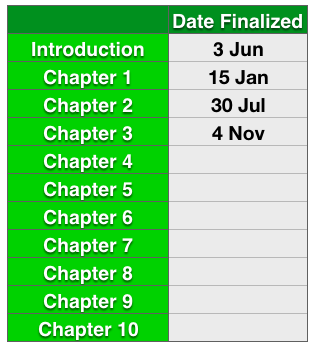 .....................................................................................................
.....................................................................................................
... Index
- Introduction to Béu
- Béu : Chapter 1 : The Sounds
- Béu : Chapter 2 : The Noun
- Béu : Chapter 3 : The Verb
- Béu : Chapter 4 : Adjective
- Béu : Chapter 5 : Questions
- Béu : Chapter 6 : Derivations
- Béu : Chapter 7 : Way of Life 1
- Béu : Chapter 8 : Way of life 2
- Béu : Chapter 9 : Word Building
- Béu : Chapter 10 : Gerund Phrase
- Béu : Discarded Stuff
- A statistical explanation for the counter-factual/past-tense conflation in conditional sentences
